Alsmeer – Visiting The World’s Largest Flower Auction
The bike and barge tour through Holland with Cycletours had another great day yesterday visiting the city of Leiden, touring an organic cheese farm and playing a game of boules. Today’s highlights will include at visit to the world’s largest flower auction at Alsmeer followed by a bike ride right through the centre of Amsterdam. Please join us.
I awoke somewhat startled by the noise of the barge engines and then remembered that we were scheduled to motor out at six for about an hour after which we would disembark and ride the rest of the way to the legendary Alsmeer flower auction. It runs 24 hours a day, but apparently most of the action is in the early morning when most of the fresh shipments arrived. After the Keukenhof this was probably the principal attraction we wanted to see outside Amsterdam. Coffee and tea were on, but breakfast would have wait until we returned. The day is shaping up to be another nice one as you can see.
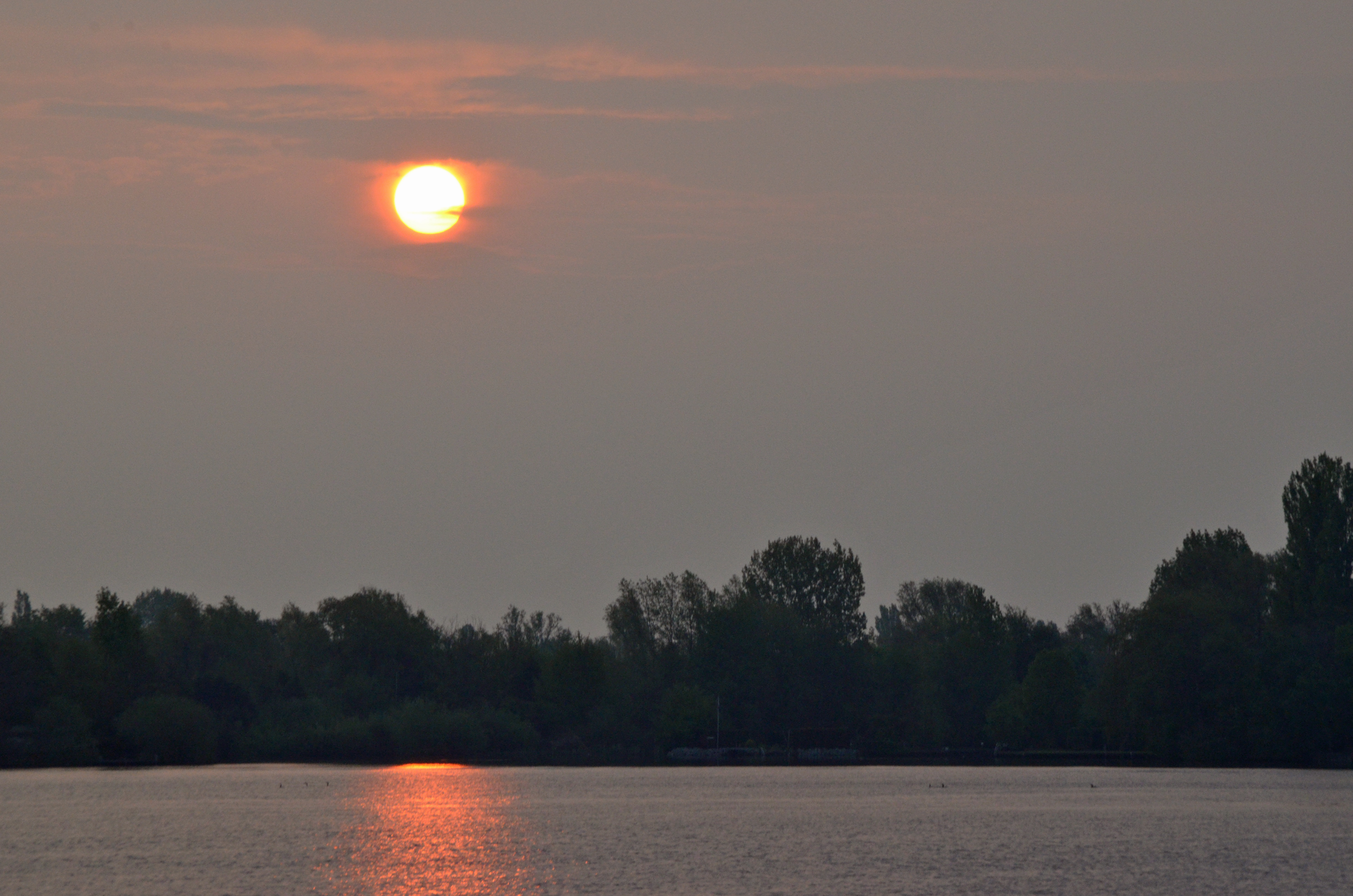
These cormorants take a long time to get airborne and they barely got out of the way of the zipping Zwaan.
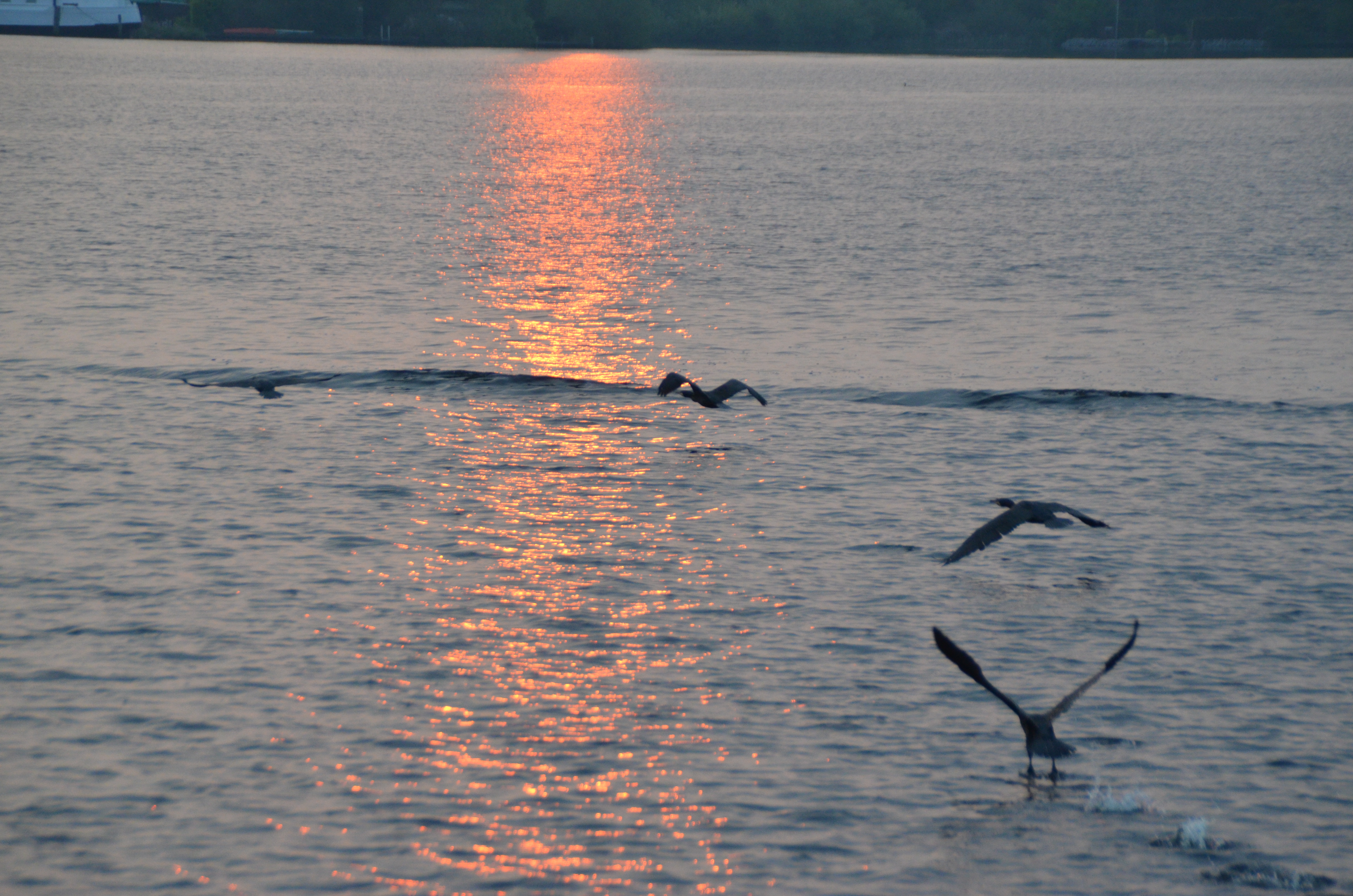
Once again the Frenchmen were all over themselves to get the bikes off and we were off to Alsmeer by seven. We rode for about half an hour and as we got closer the number of trucks on the road beside us increased dramatically until virtually all the traffic was Alsmeer market bound. In the distance I could see an absolutely immense building looming ahead. This was Flora Holland, a Dutch co-operative that dominates the world trade in cut flowers and is housed in one of the largest buildings on the planet. Here the co-operative growers bring their flowers to be sold to the highest bidder and then trans-shipped around the world through nearby Schipol airport. The flowers that are sold this morning could be in my local Superstore by tomorrow morning.
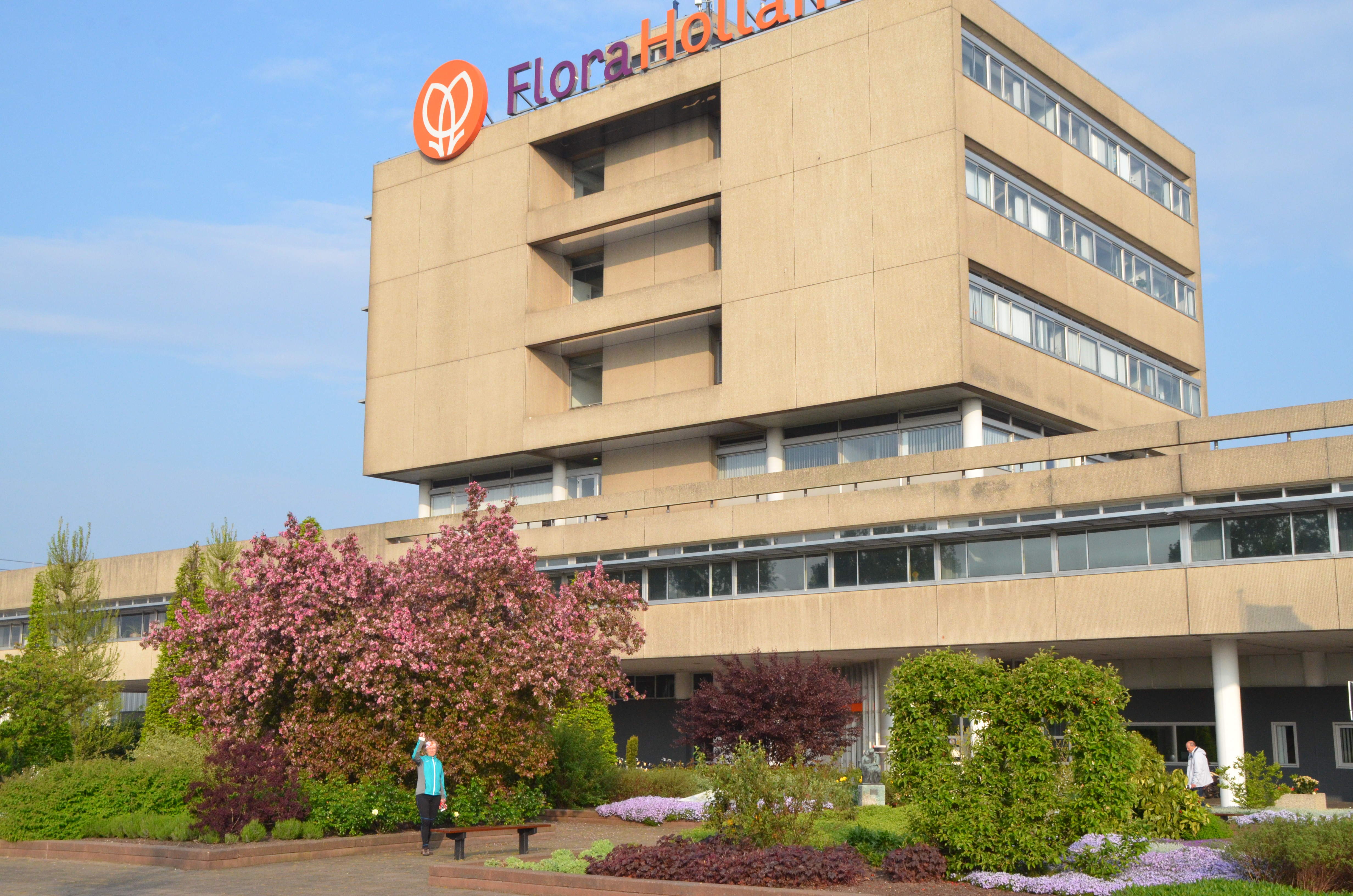
Once again having a bike proved a great advantage as we were able to pedal right up to the tourist entrance and chain our bikes together there. While we were waiting for Albert to get the tickets I noticed that there were a number of interesting planters near the entrance to which the Easter bunny had paid a recent visit. See if you can spot his leavings.
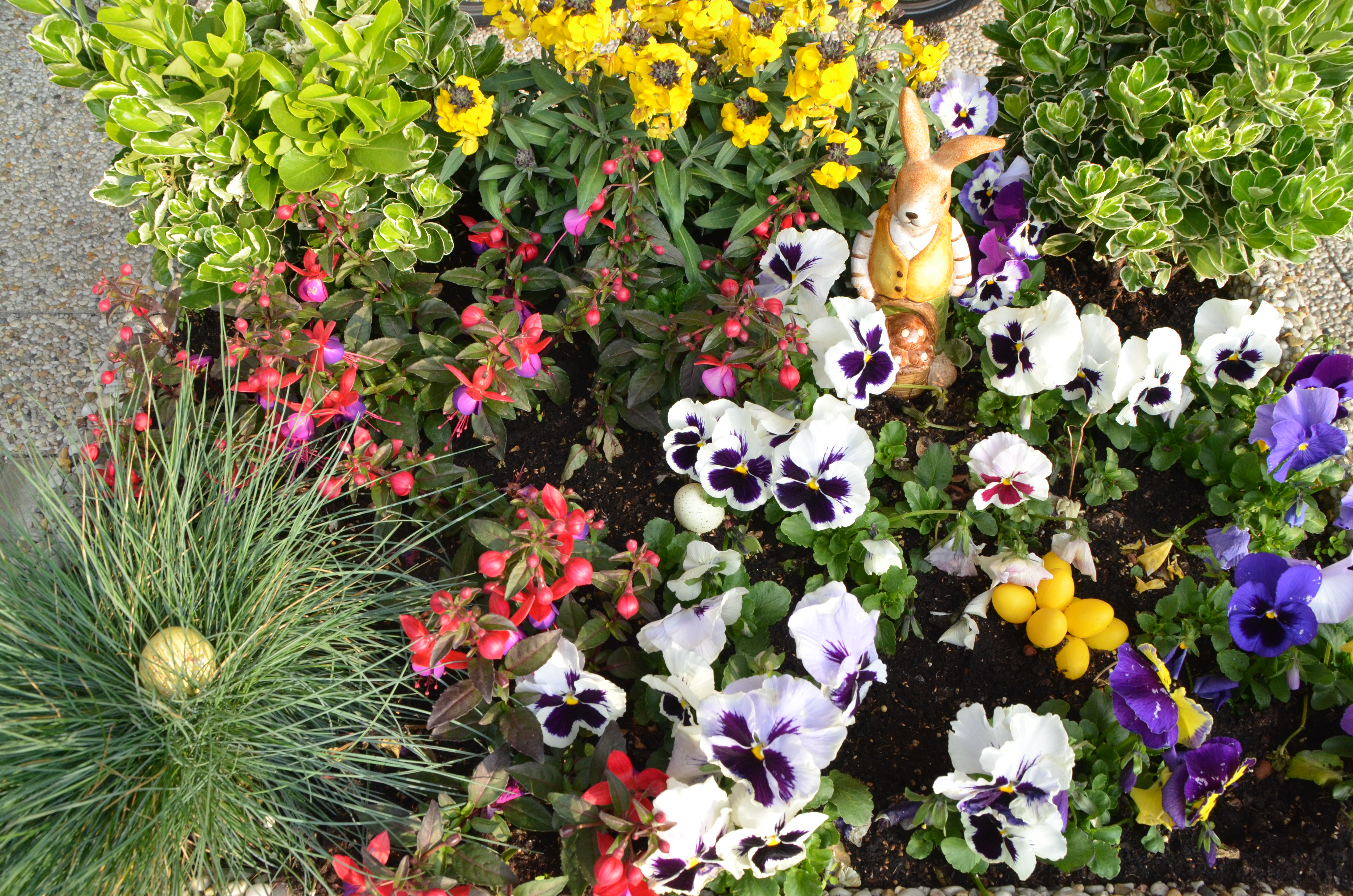
Albert came with the tickets and said we had until 9:00 to observe the goings on inside the massive building. He explained that there was a walkway over a kilometre long from which we could look down on the flowers being transported hither and thither. Near the end of the walkway was the actual auction room. The first impression of the inside of the Alsmeer flower market is pretty obvious – the immensity. It is by far the largest building I have ever been in, longer than twelve football fields. The second is less obvious, this may be the closest thing that you will ever see to a human ant or bee colony. Below us on the walkway are men driving little tractors hauling multiple flat cars either loaded with flowers or on their way to be loaded. There are also automated trams on which more car loads of flowers are being whisked about. The piloted and unpiloted transporters of flowers move in no recognizable patterns so that it gives the initial appearance of chaos, but like an ant colony, every worker has its purpose and the whole operation has a unified purpose. Alsmeer is the very definition of ‘hustle and bustle’.
By the time we were about a quarter of the way along the catwalk there was nothing but flowers below us. There is nothing in my experience I can compare it to. Some flowers, like these roses, were not quite open yet.
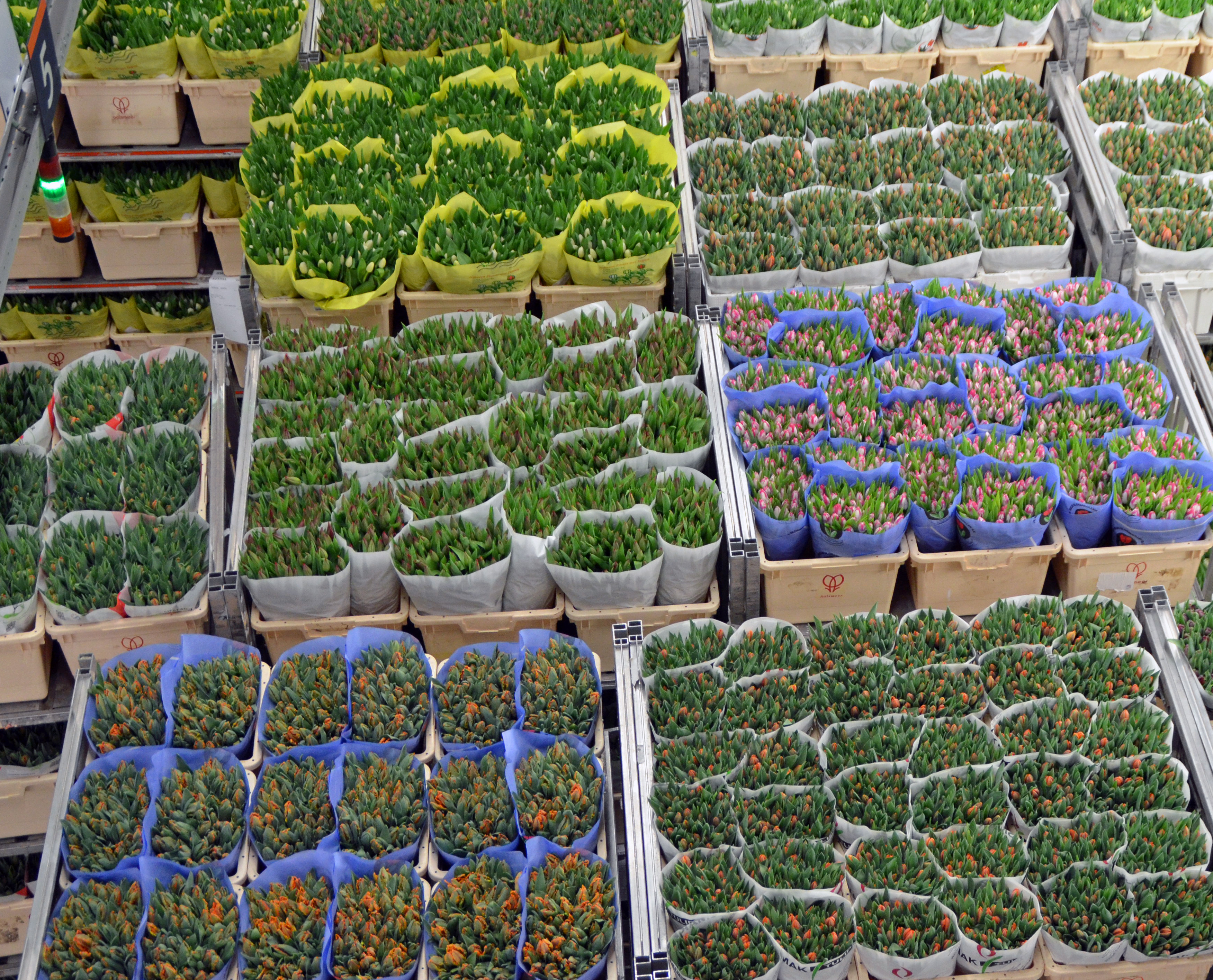
While others were in full bloom.

In preparation for Koningsdag which was coming up on Saturday there were an extraordinary number of orange flowers, like these gerbera daisies, orange being the national colour of Holland.
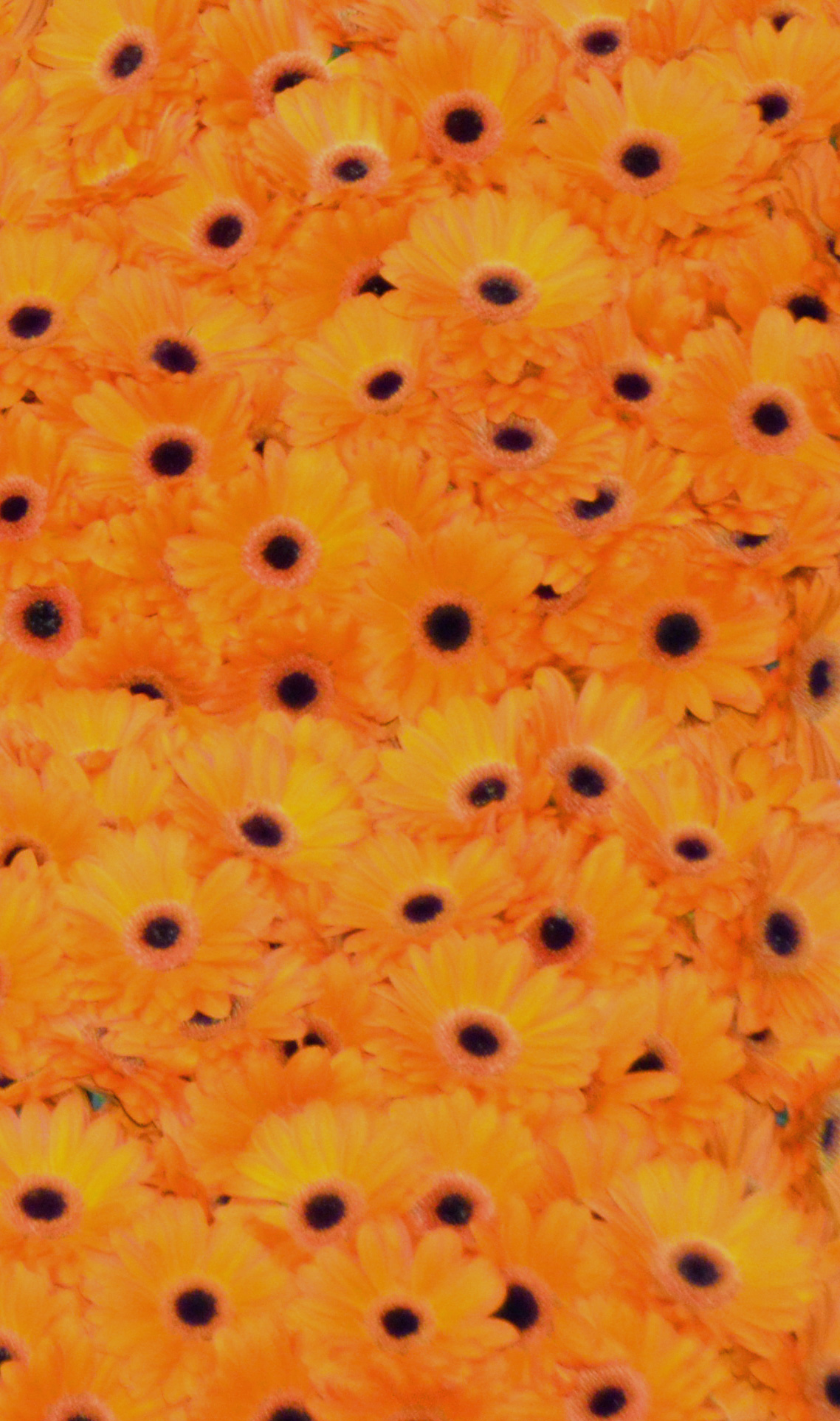
At the end of the catwalk we came to the glassed in auction room which had seats for at least a hundred bidders, but this morning not many were occupied and the potential bidders seemed to be spending more time talking on their cell phones than watching the bidding process. A tram would pull up in front of the auction room loaded with perhaps ten thousand flowers of a similar kind and the information about their grower and their qualities was posted on a huge digital screen.
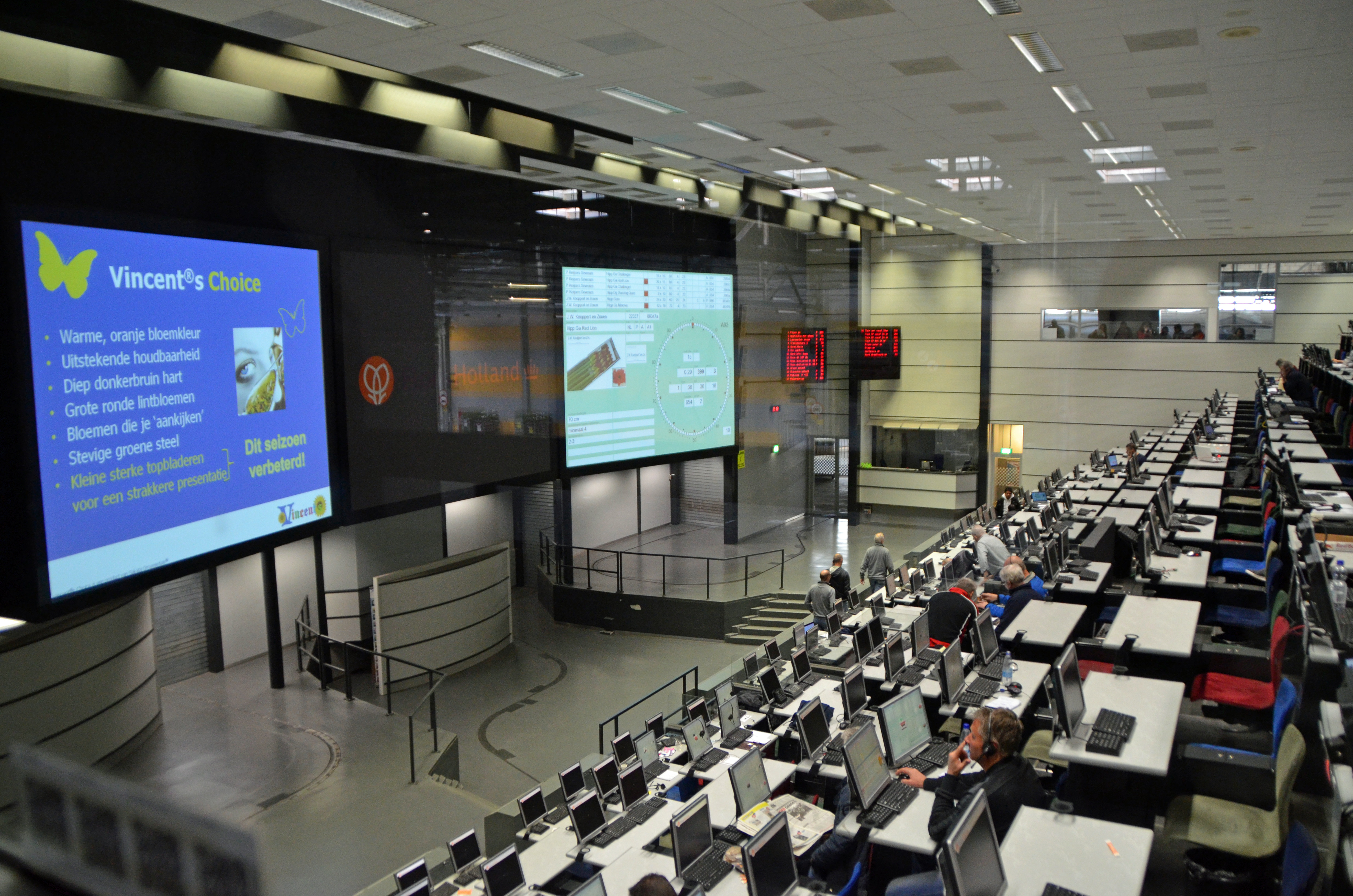
What I found intriguing was the fact that each individual grower was responsible for the quality of the merchandise as opposed to some corporate non-entity. Can you imagine an individual being on the hook for a screw up by say a bank or a food provider in Canada? I thought not. The Dutch idea of communal cooperation also comes with the idea that an organization is only as strong as its weakest link. If individuals are not held to account for their mistakes then the integrity of the entire operation is at risk, which I suspect is why the Dutch have been able to virtually corner the world market on flowers.
After passing by the auction room we returned to the entrance via a parallel catwalk. Arnaud took this picture of us on the way back.
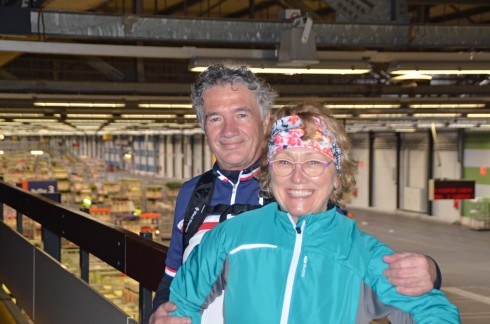
Like the Keukenhof, Alsmeer had a really crappy gift shop with more souvenirs for the Amsterdam red light district than for the actual reason we were in the gift shop.
Waiting for the rest of the group I contemplated what I had just seen. The entire scope and purpose of Alsmeer was to provide people with things that have no inherent value or use other than to make them happy. Flowers brighten up even the darkest of days, literally and figuratively. The incredible capital cost of constructing this building must have been a daunting task for the cooperative, but it has succeeded and brought with it tens of thousands of jobs in the process. We often hear the saying that such and such an enterprise will bring ‘good’ jobs to the area. Well I can say without reservation that jobs that are involved in making armaments, guns or hazardous chemicals are not ‘good’ jobs. They may be well-paying, but they are by no means good. On the other hand the workers I saw today at Alsmeer had ‘good’ jobs in every sense of the word.
Emma pointed out one anomaly that I did not notice. Although the workers we saw from the catwalk seemed to come from every race and nationality, they were all men – not a single woman among them. There were a couple of women in the auction room, but that too was overwhelmingly male. How strange that, while women are undoubtedly the recipients of the majority of flowers given as gifts, that so few would be involved in the flower growing industry.
This time everybody was back at the bikes at the prescribed time, but somehow Martine had lost the key to her bike. She was in a complete panic, until by some miracle we found it lying on the sidewalk not ten feet from where she stood. We had a short pedal back to the Zwaan which had moved further up the canal in our absence. Dorus had a hearty breakfast waiting after which we motored up the Schipoldijk towards Amsterdam. It was an interesting cruise as we approached Schipol airport with the massive KLM headquarters on on side of the canal.
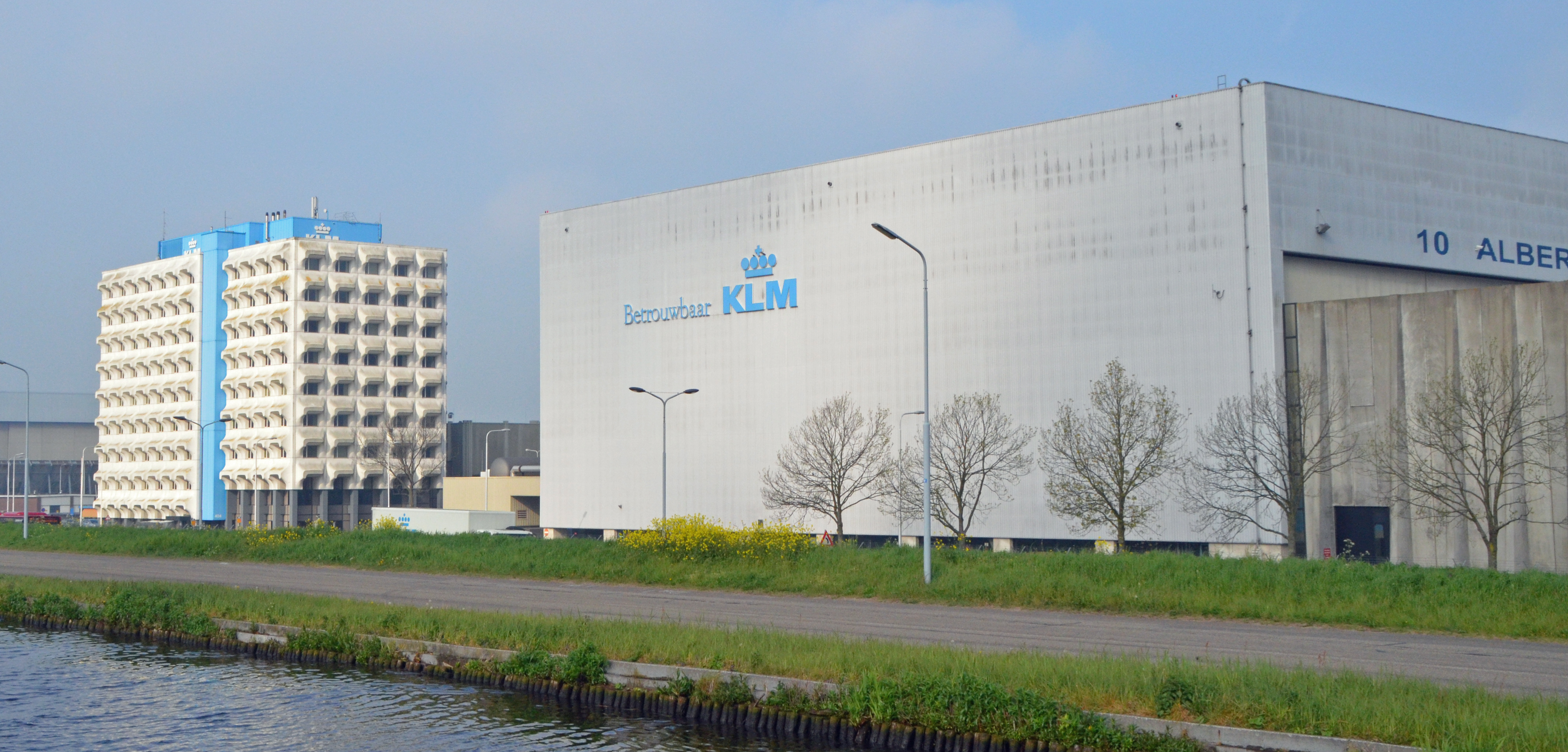
And this horse farm on the other.
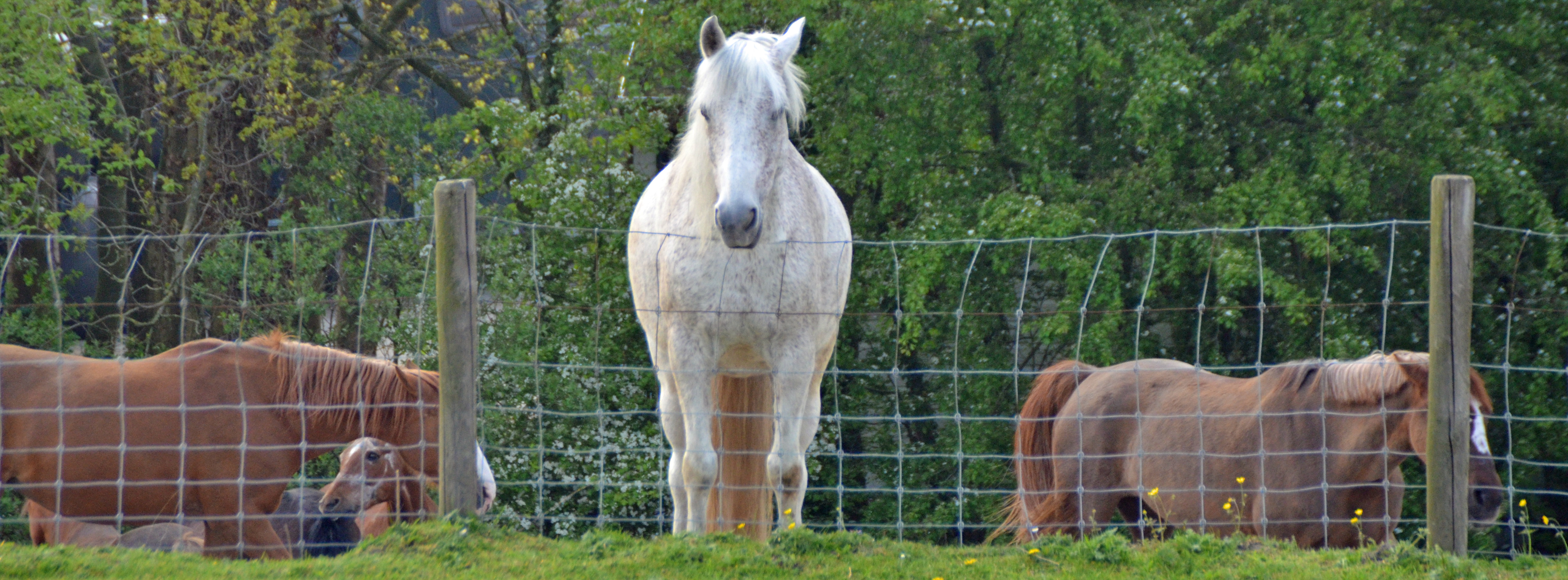
I also noticed this small fleet of boats done up in the colours of the Dutch flag.
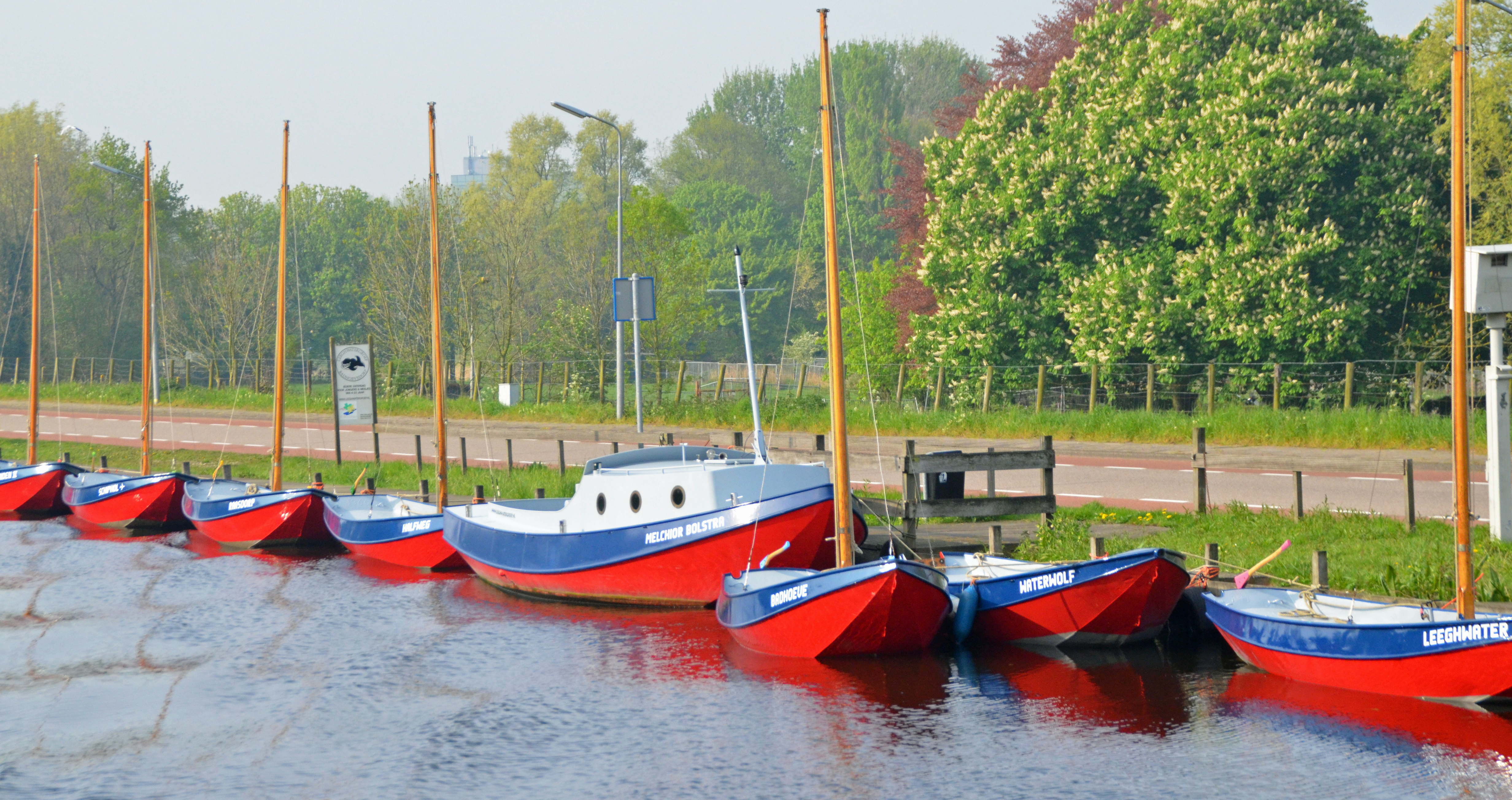
After about an hour of motoring we pulled into a big lock which Albert said was the principal southern entrance into Amsterdam for water traffic. The bridge dutifully opened, stopping all Amsterdam bound cars and bikes for a good five minutes.
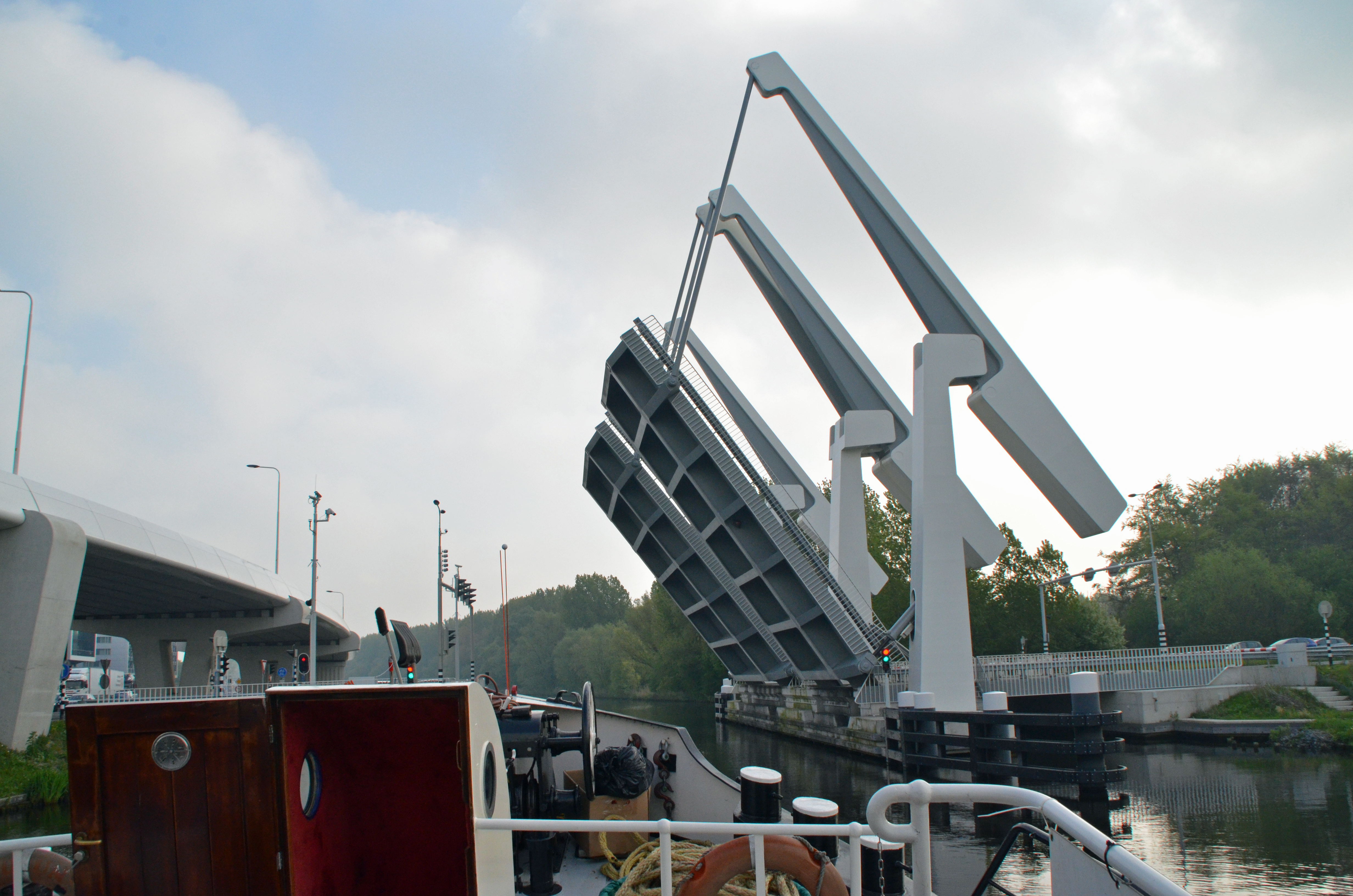
Once inside we hastily tied up and unloaded the bikes before the Zwaan started lowering as the water was pumped out of the lock. We waved goodbye to Marije whose duties included those of first mate and headed for Amsterdam.
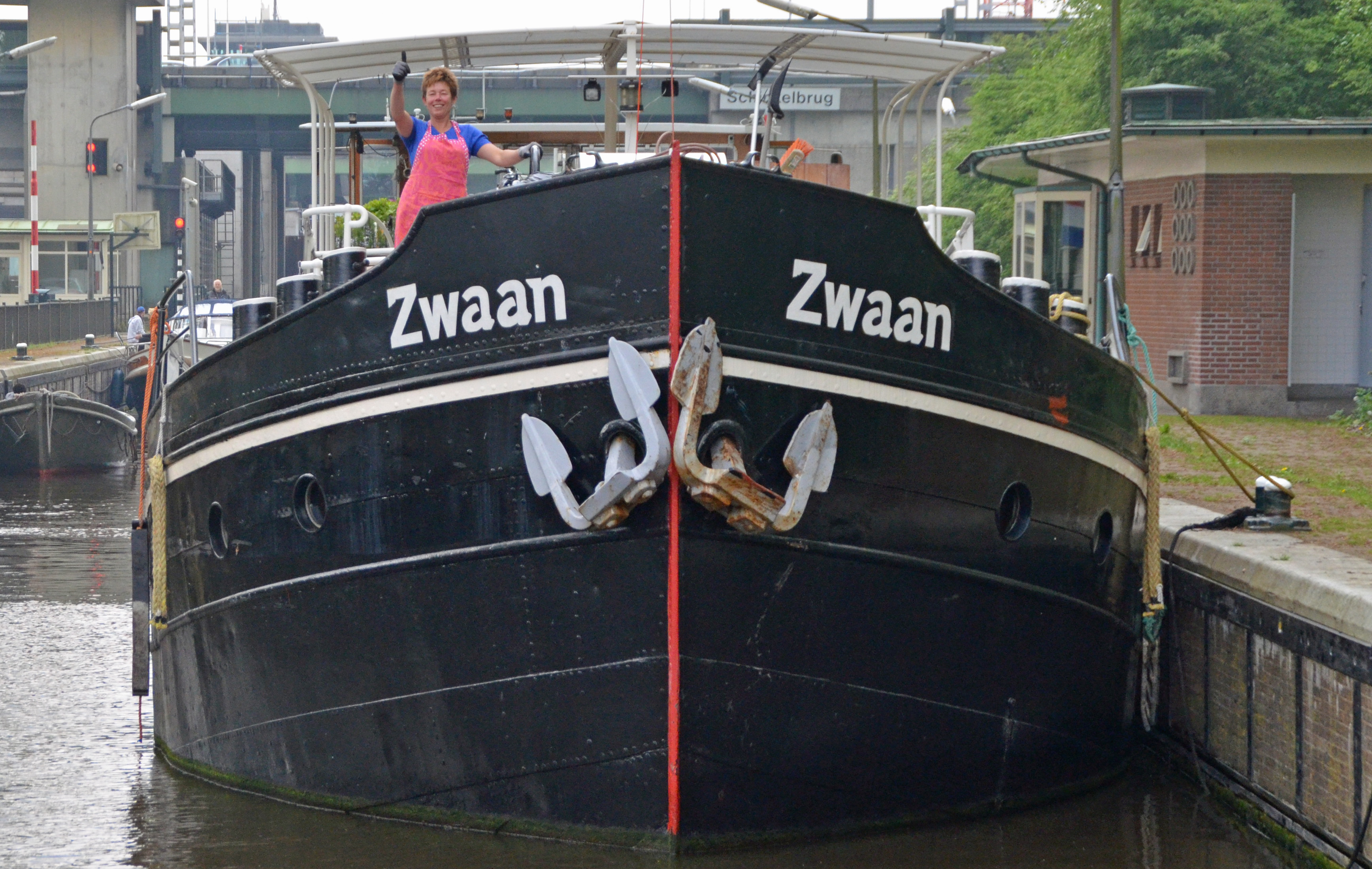
If anyone told me that I would be let out on one side of a major North American city and that they would meet me on the other side after I pedalled directly into the heart of the city and out again, in two and half hours I would say they were nuts. Not so in the case of Amsterdam. Albert led us on a route that was almost entirely on dedicated bike paths through the Amsterdam Bos, the city’s version of the Bois de Boulogne in Paris where we stopped briefly at the site of the 1928 Olympic rowing venue. We then cycled through the suburb of Amstelveen (suburb is really not the right word as Amstelveen is every bit as old as Amsterdam) to the banks of the Amstel River where we stopped for one more Rembrandt monument. Apparently the great artist loved to come to this area to paint the river and the windmill. We snuggled up to the great man for one last time.
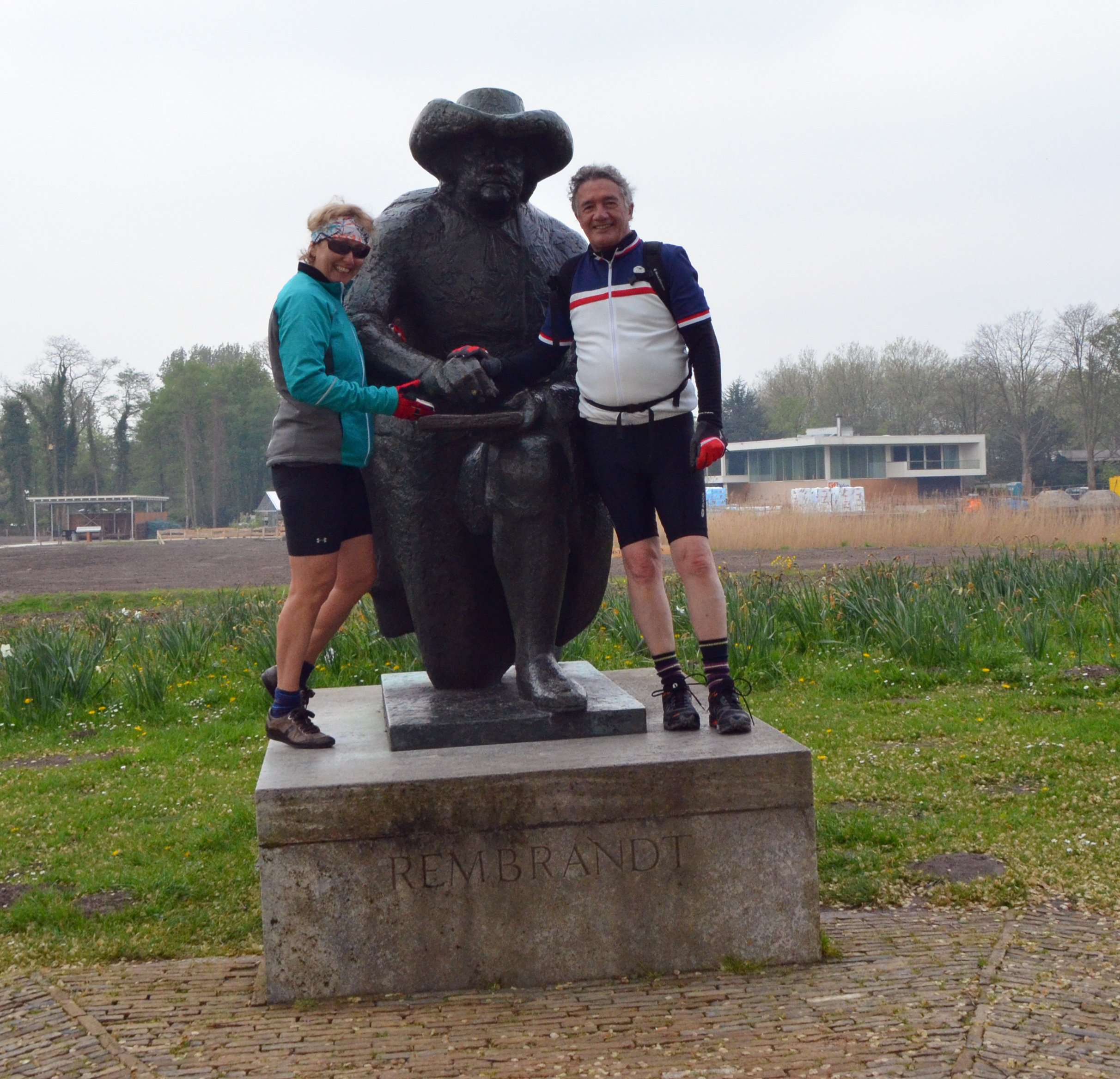
While Amsterdam certainly doesn’t have any mountains it definitely has molehills which are evident in this photo of the Rembrandt windmill.
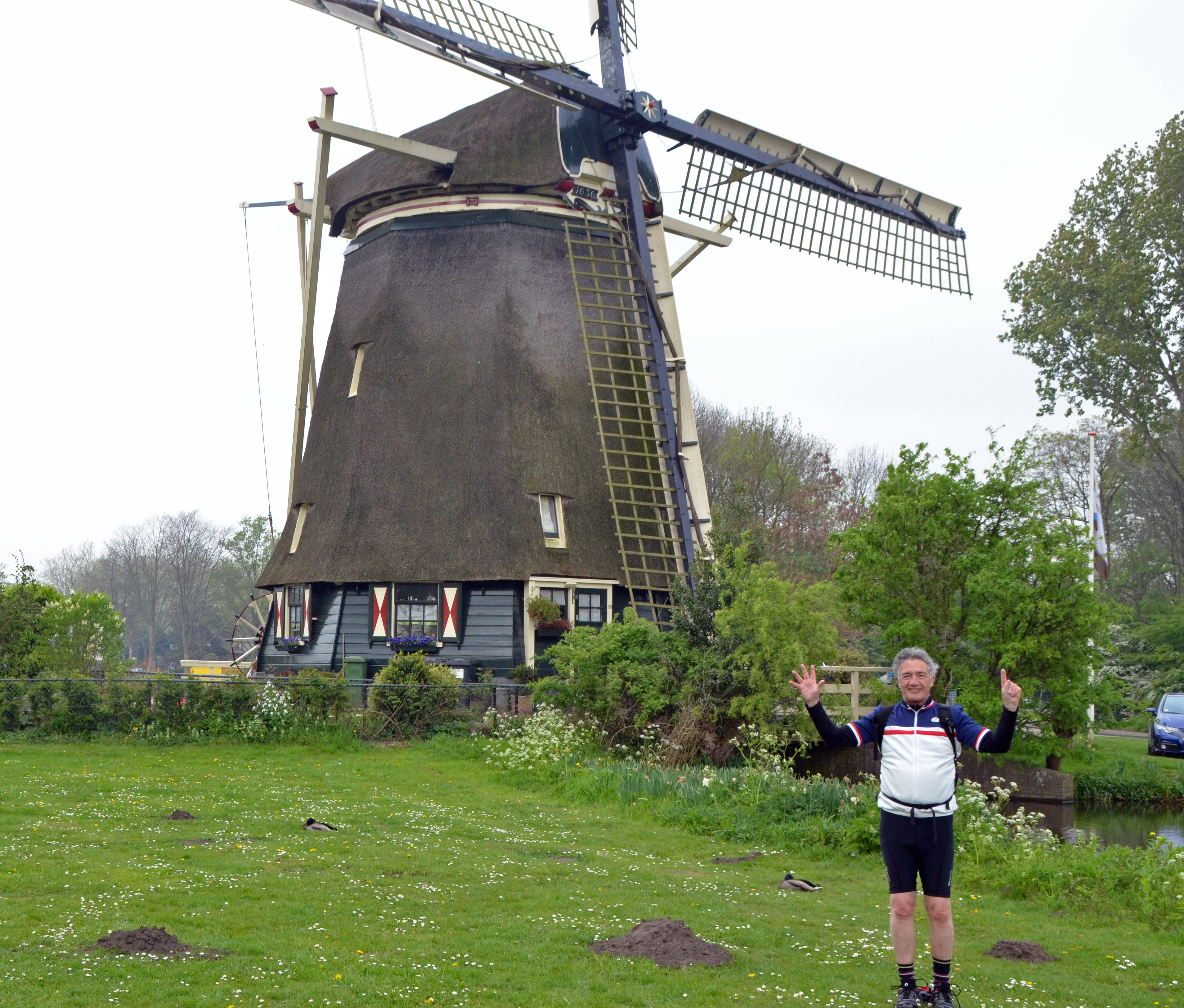
We then followed the Amstel right into the heart of the city where the bike traffic became the equivalent of a traffic jam, but the group managed it alright except for Brigitte who faltered on a narrow bridge, fell over and caused about a dozen bikes to crash behind her. Miraculously no one was hurt and the Dutch took it in good stride – just another dim witted tourist. We stopped near the Amsterdam city hall which is built on the remnants of the old Jewish quarter. There is a statue of the great Baruch Spinoza who was born, raised and excommunicated here by the local rabbis. Good for him.
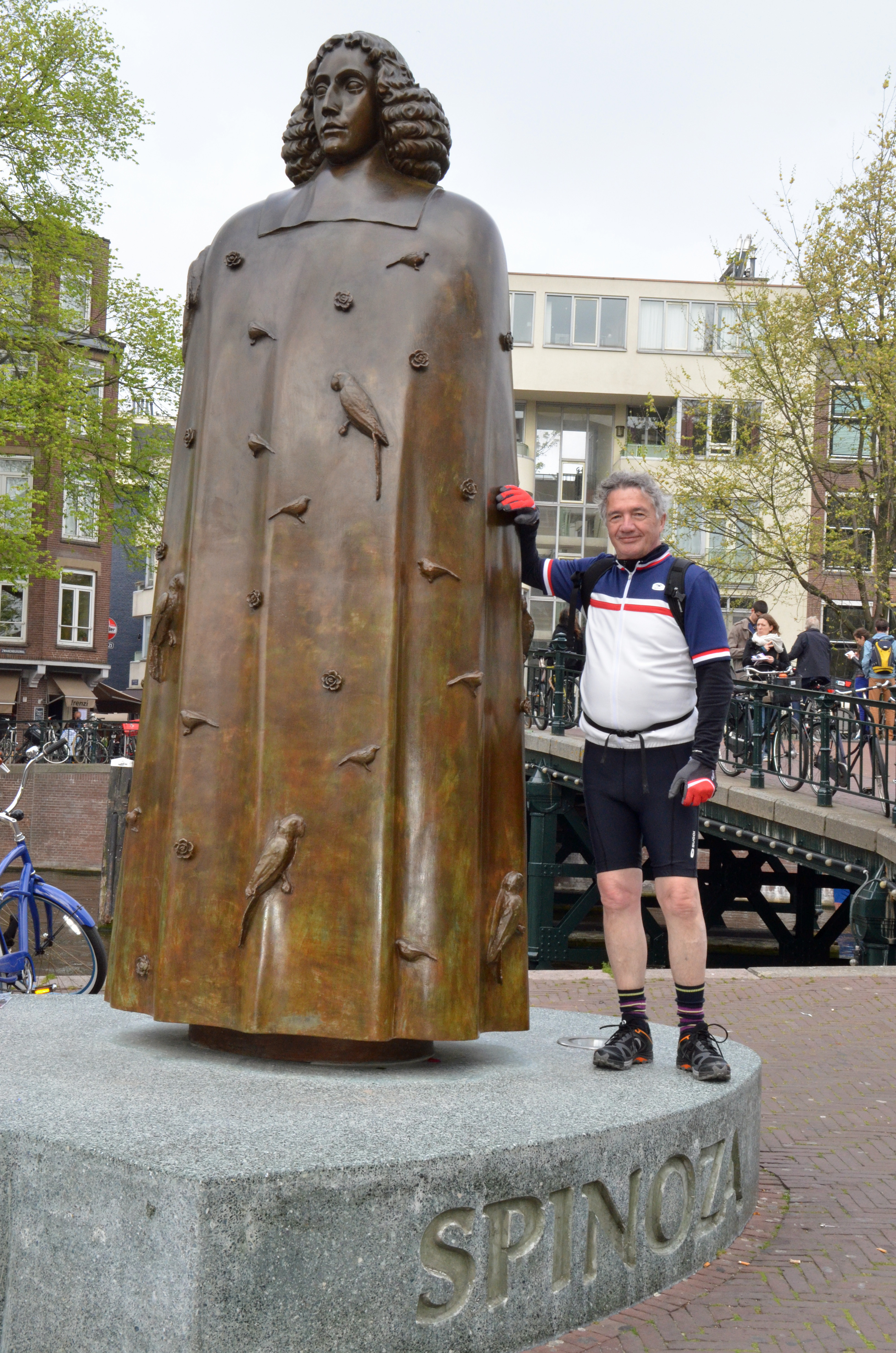
From central Amsterdam we proceeded to the ferry terminal across from Central Station and crossed to the north side of the city and headed for the open country. Along the way a little boy of about five in a cowboy hat pointed his finger at us as we went by and yelled “Bang, Bang” or the Dutch equivalent. I thought about scaring the hell out of him by falling off the bike and pretending I was shot, but instead chose to return fire with my finger. Not long after I started to notice garbage alongside the path, something unusual for Holland and then I looked up and saw the bloody Golden Arches. Years ago MacDonald’s wanted to put an outlet in Sanibel, but the residents fiercely opposed it by putting McSpoil bumper stickers on their cars. These caught on all over the state and Ron gave up. Seems to me the Dutch might need a similar campaign or at least force MacDonald’s to come up with a plan to deal with the inevitable garbage that their slovenly customers generate.
We stopped for a late lunch in a park and it was only then that I realized how quickly we had navigated through Amsterdam in two and half hours. We continued north to Zaanse Schans, an historic village that was very apparently on the tour bus route as it was crawling with bedraggled looking groups of mostly Asians with a few Poles and Russians thrown in. It was Holland’s version of Upper CanadaVillage. It brought home to me the fact that most tourists who go to Holland are on tours that are shuttled from one over crowded venue to another without ever getting the chance to enjoy the peace and quiet of the Dutch countryside.
Albert took us to an exhibition of wooden shoe making where it was interesting to learn that Canadian poplar is the favoured wood for these shoes.
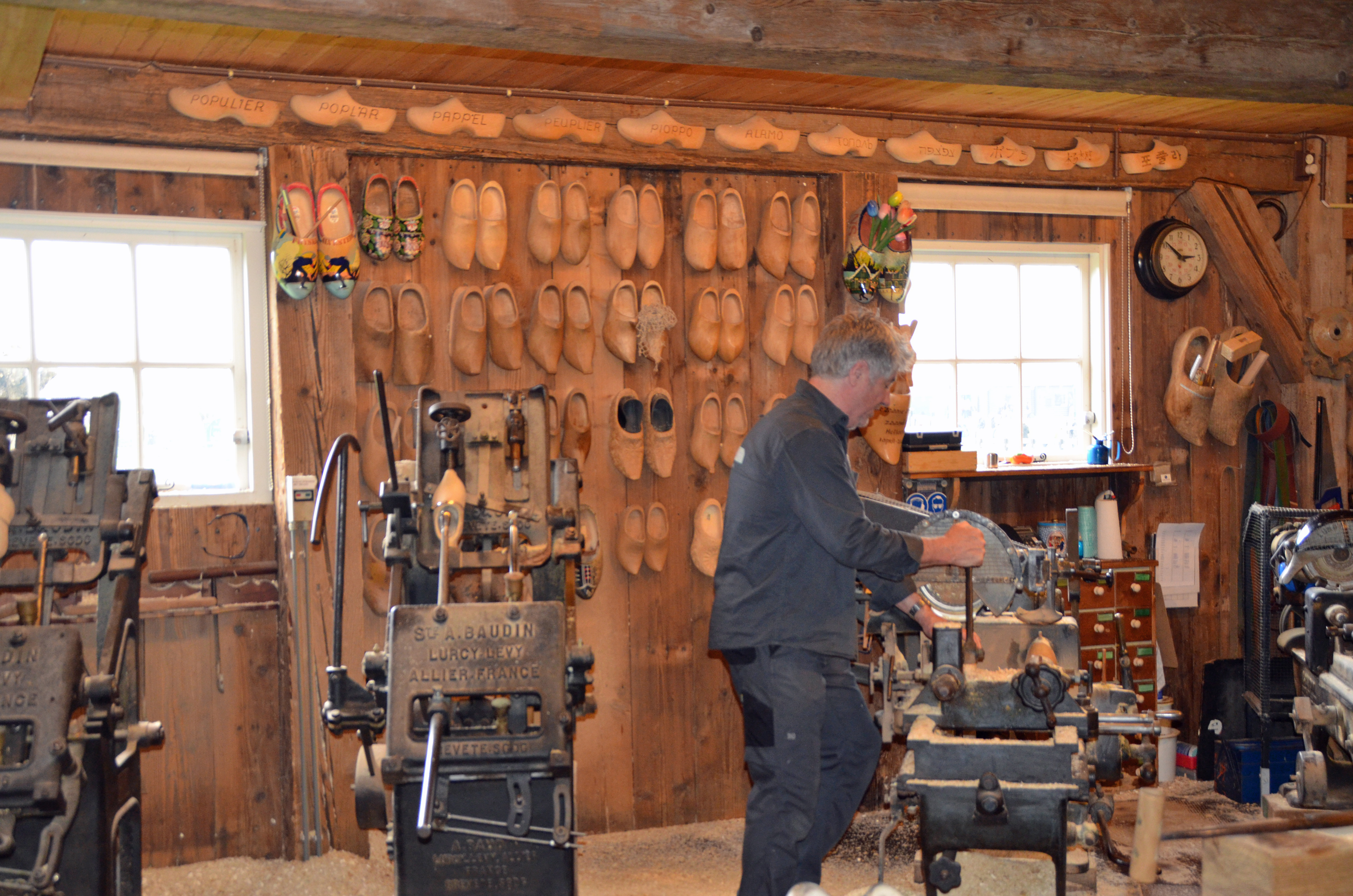
The gift shop at the wooden shoe museum was in the business of pushing wooden shoes of which I have no idea what you would do with except maybe use as a door stop, but that wasn’t bothering the Chinese tourists who were snapping them up like hotcakes. If I ever get to China I’ll look for wooden shoes outside the homes as a status symbol of having been abroad. However, decorated wooden shoes do make for a nice picture.
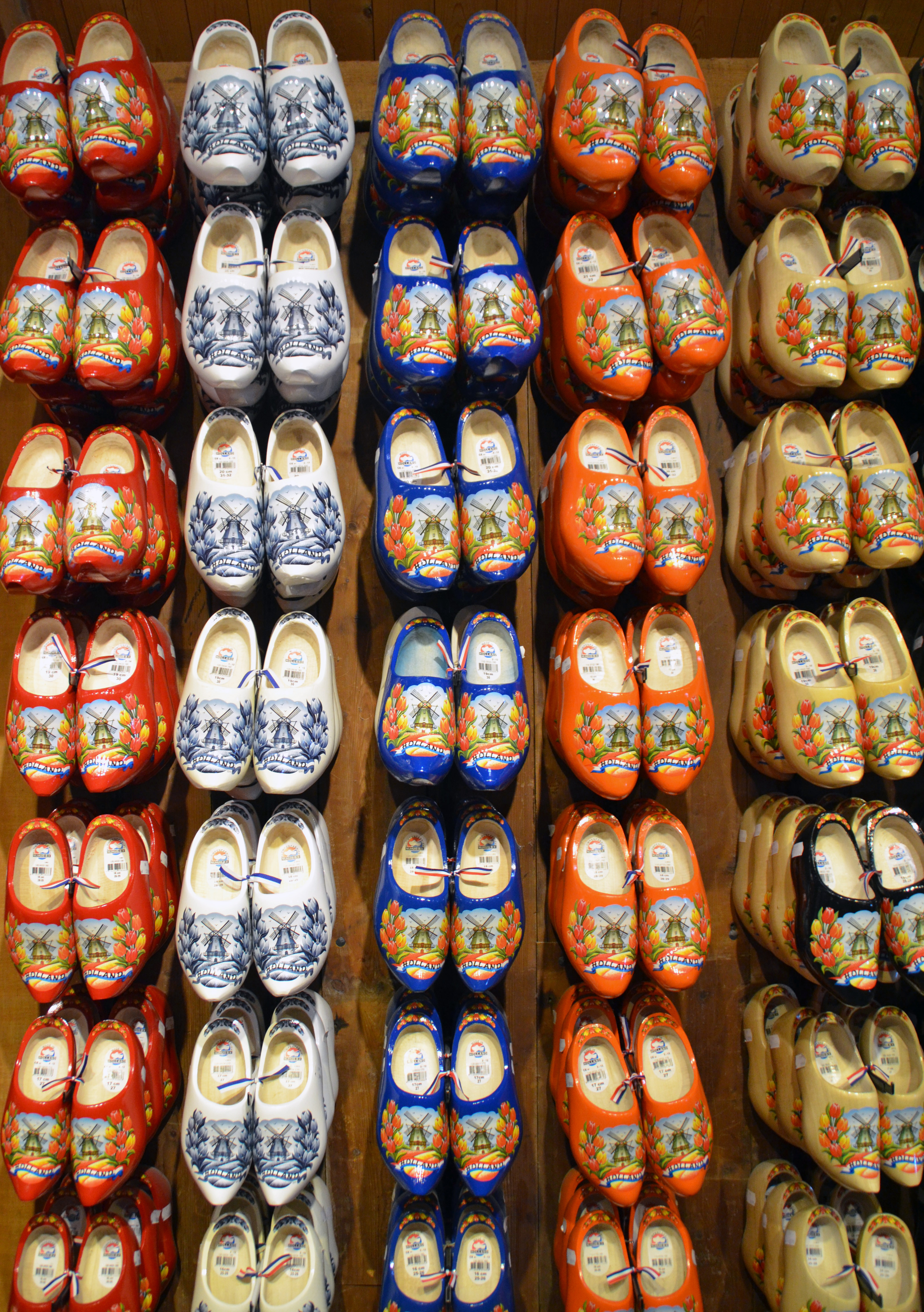
Aside from the wooden shoe museum there were quite a number of buildings to explore at Zaans Schans, most of which were dedicated to one particular craft. By far the most interesting were the four windmills, each of which specialized in a different use. One ground spices and coffee, one was a sawmill, one made paint (don’t ask me how) and one processes oils. While they are all very photogenic, most having been moved here from other sites and located specifically to look good, I really didn’t like the fact that each one wanted three and a half euros to go inside.
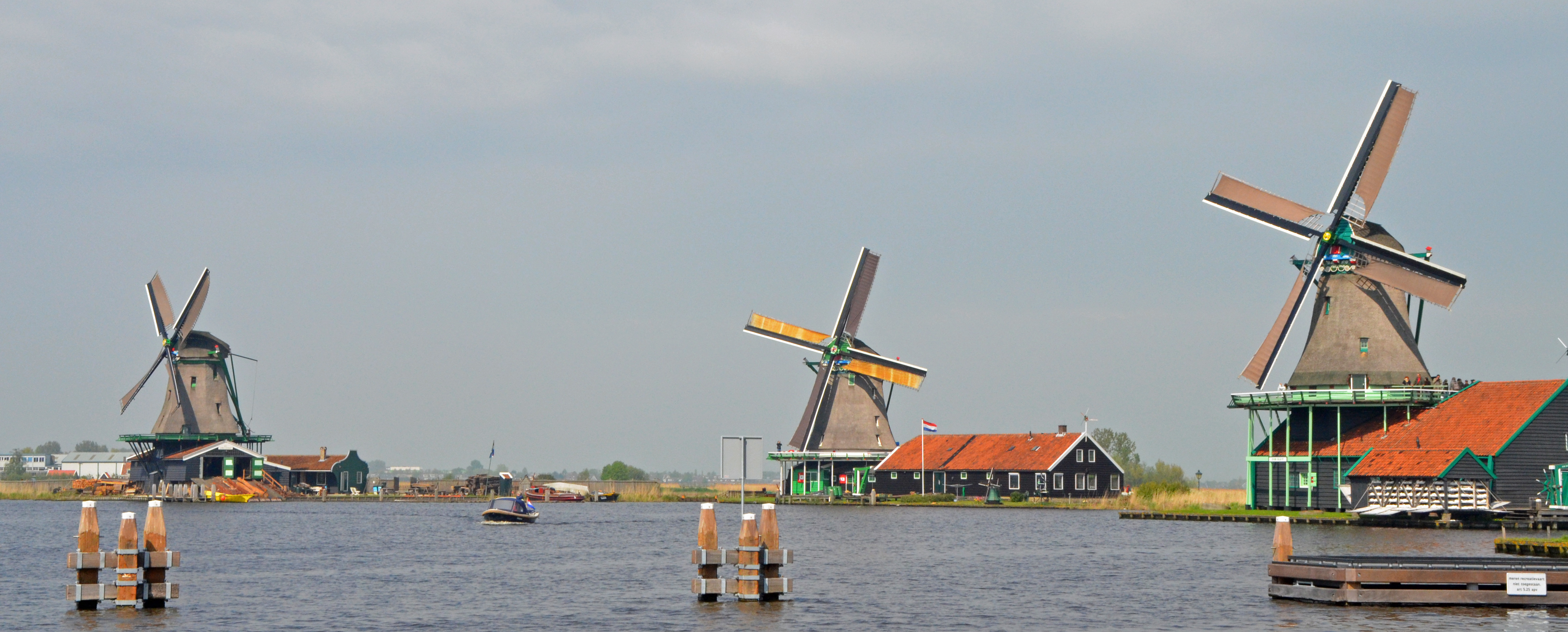
I had a brilliant idea for a really neat picture. Alison and I would stand in front of the windmills and hold our arms out to create our own human windmill. I recruited Emma to do the shot and she had us move our arms until they were in the right configuration – or so I thought. The result was an epic fail that I should be too embarrassed to post, but I have no shame.
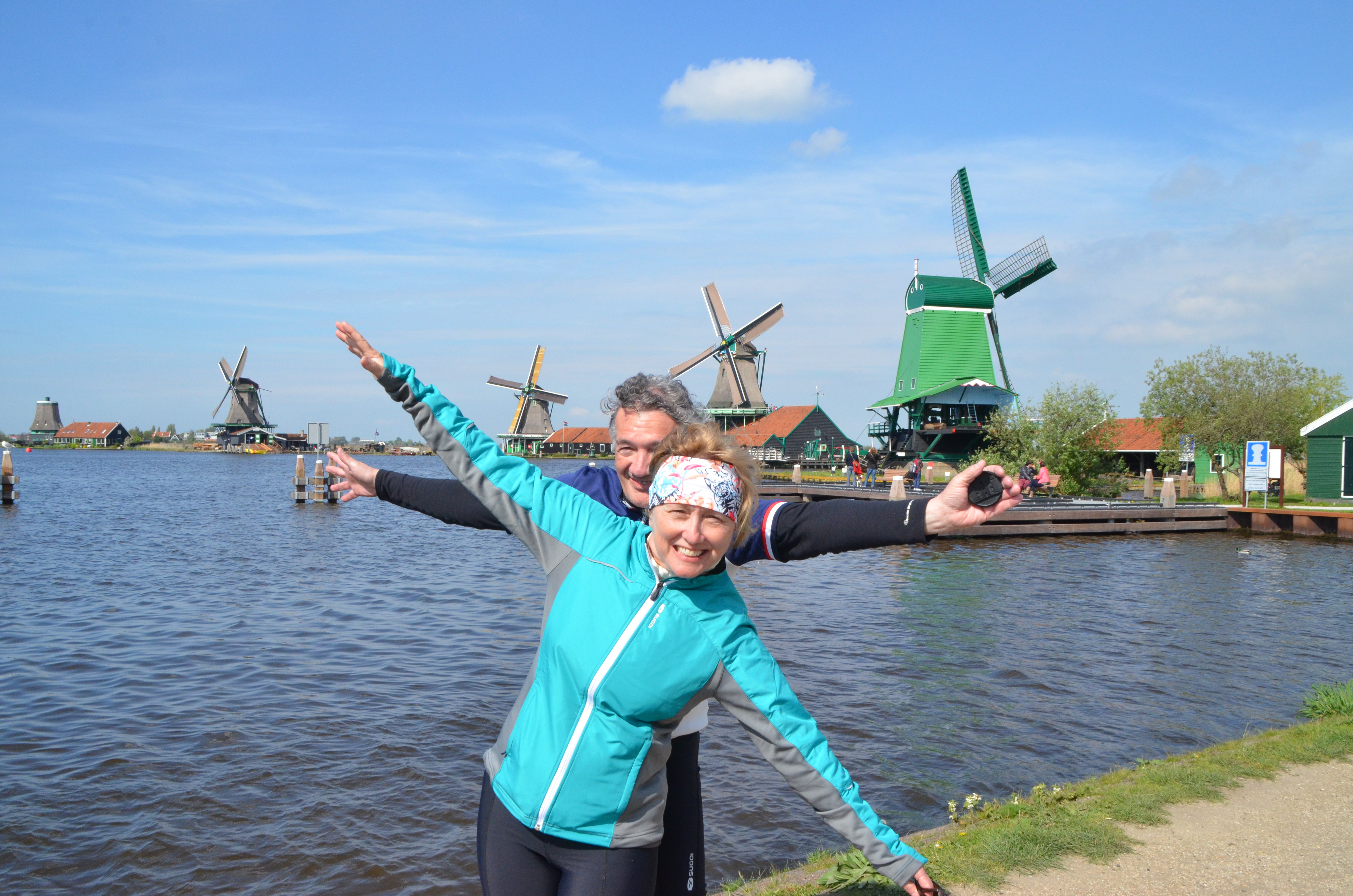
While all eyes were on the windmills and other man made attractions I noticed this pair of lapwings doing an aerial mating dance. Mother nature does not take a back seat to anything we can create.
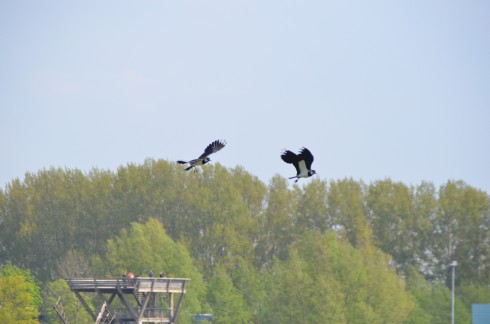
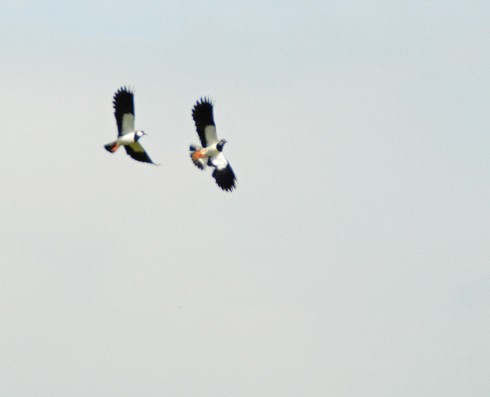
We stayed at Zaanse Schans for about two hours of which we spent the last half an hour enjoying a beer with our French compadres who were less than overwhelmed by the place. By now my high school French was coming back better than I ever thought it would and we were able to communicate reasonably well.
It was about an hour of easy cycling to the Zwaan which was moored on the Zaan River in the town of Wormerveer. That night Dorus outdid himself with a real feast that featured rabbit tournedos wrapped in bacon. I can honestly say that I have never enjoyed rabbit until I tasted it tonight. Rather than being tough and overcooked this rabbit was tender and succulent. I asked Dorus where he learned to cook this dish and he astonished me by saying it was the first time he had ever made it. This guy is just a natural chef.
Getting up early to get to Alsmeer had been more than worth it, but it meant an early night. Tot ziens.

